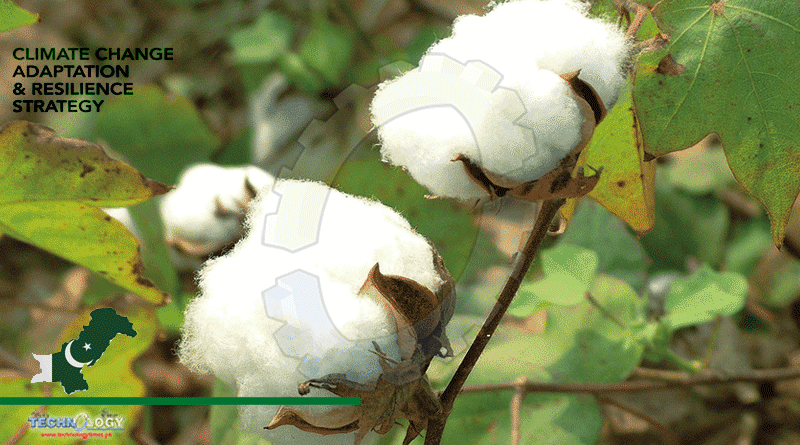Adapting To Weather Patterns Is Necessary And Through New Cotton Varieties Suited For Changing Climatic Scenario In The Country

Cotton, linen and silk are textiles associated with fashion and fashion capitals of the world, such as Paris, Milan, London and New York. Some of those textiles popular with designers are produced in Pakistan, where the textile industry contributes 8.5 per cent to the gross domestic product and accounts for 60 per cent of the country’s exports. But climate extremes such as heatwaves and increasing temperatures have been impacting the cotton industry, which has seen an unprecedented fall in yields. The IAEA, in partnership with the Food and Agriculture Organization of the United Nations (FAO), is working with local experts to develop and introduce new varieties of cotton that are more resilient and better adapted to the new climate reality in the country. The new varieties developed now account for 40 percent of all cotton produced, up from just 25 per cent two years ago and from non-existent yield in 2016.
“Year on year variation in yields of the cotton crop due to climate change is not only impacting the farming industry negatively, but it is also straining development of the entire cotton-based value chain in the region,” said Manzoor Hussain, Deputy Chief Scientist and cotton breeder at the Nuclear Institute for Agriculture and Biology (NIAB), in charge of the project in Pakistan. “Agriculture is central to Pakistan’s economy, and cotton has a significant role in driving the economy of the country. Through nuclear techniques, we can ensure that this economic area remains profitable.”Textiles and the cotton industry
The support and training in plant mutation breeding and selection by the IAEA and FAO, through the IAEA technical cooperation programme, has helped pave the way for the NIAB release of four cotton varieties since 2016 (see How can plant mutation breeding combat climate change?). All over the country, the popularity of these varieties has been steadily growing. “I was able to harvest my crop this year with a 30 per cent higher yield than what I could achieve with traditional varieties,” said Muhammad Ikram, a farmer from the Bahawalnagar District, located 500 km south of Islamabad, noting that this growing season was a difficult one for cotton growers around the country. “The heat tolerance and yield with these varieties even under the changing weather is very important for the farming community.”
To continue to support the textile industry, which employs 40 per cent of the labour force in the country, the release of new cotton varieties continues. These new varieties have a higher yield and improved fibre quality as well as good agronomic performance and adaptability to climate change variation. “Heat stress in cotton resulting from increasing temperatures and instances of drought can impact the yield and, therefore, the income of farmers,” said Ljupcho Jankuloski, a plant breeder and geneticist at the Joint FAO/IAEA Division of Nuclear Techniques in Food and Agriculture. “Through the use of mutation breeding technologies, new varieties that are adapted and resilient to climate change and with improved fibre quality can be used to continue to meet the needs of the population despite changing weather patterns.”Improved resilience for millions of people
The collaboration between the NIAB, the IAEA and FAO include a long-term technology transfer and capacity-building programme. Having this focus, the partnership has included training, workshops and fellowships – training Pakistani scientists in plant breeding techniques focused on developing cotton varieties tolerant to drought and high temperatures. “Building capacity in plant breeding at the national level has become the main focus and we are continually working towards this through training courses and workshops,” said Hussain. “There are millions of people involved in the cotton industry in Pakistan – adapting to the weather patterns is necessary and through new cotton varieties suited for the changing climatic scenario in the country, this is possible.” Using nuclear techniques, the first cotton variety was released in Pakistan in 1983; since then, a total of 16 cotton varieties have been developed. The four latest varieties to be released are expected to make up 56 per cent of seeds planted throughout the country in the coming months.
Through this long-standing collaboration, Pakistani scientists have reached a level of expertise that they can share with neighbouring countries that are in the early stages of mutation breeding. With this combination of suitable facilities, technical know-how in cotton mutation breeding and improved cotton varieties in the field, the NIAB can now host IAEA training for experts from neighbouring countries enabling field visits to see crop performance in the field. Through the IAEA training that NIAB has hosted, cotton varieties have been developed in neighbouring countries for the first time, Jankuloski said.
THE SCIENCE
How can plant mutation breeding combat climate change?
Seeds are first exposed to irradiation with gamma rays and then planted in growth chambers or greenhouses. Plants arising from the irradiated seeds are planted and advanced over three to four generations during which they are examined and selected for the traits targeted for improvement in the programme. Once suitable plant lines have been identified, they are planted in different locations (agro-ecological zones) of the country – representing various climatic and soil conditions. Once an advanced line/s has proven its performance in such multi-locational trials, it is released as a variety for cultivation by farmers. The seed of the variety is then multiplied so that farmers have access to sufficient amounts to plant. Through implementing plant mutation breeding techniques, scientists can access novel genetic diversity that is not accessible through conventional breeding, and thus ensure the identification of new and improved lines in a shorter time, enabling the development of improved plant varieties adaptable to climate change and tolerant to abiotic stresses, such as heat and drought.
This news was originally published at Devdis Course
